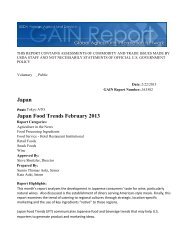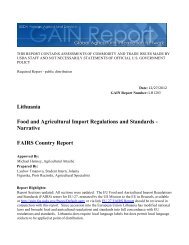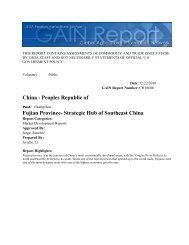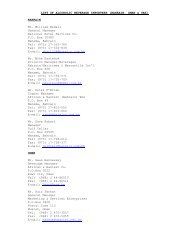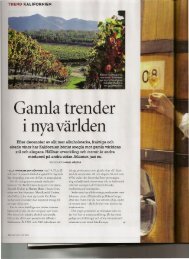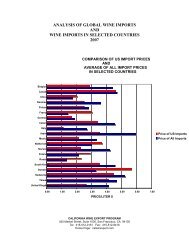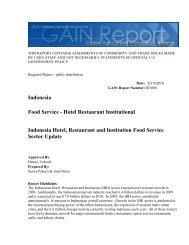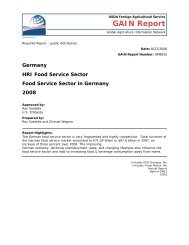Brazil Wine Market Report JBC EMP July 2011 - California Wine ...
Brazil Wine Market Report JBC EMP July 2011 - California Wine ...
Brazil Wine Market Report JBC EMP July 2011 - California Wine ...
Create successful ePaper yourself
Turn your PDF publications into a flip-book with our unique Google optimized e-Paper software.
§ 1 The acidification may be carried out as follows:<br />
I - by the spontaneous precipitation of tartaric acid;<br />
II - by cutting with lower acidity of musts;<br />
III - by the use of heat treatment (cold);<br />
IV - the microbial degradation of malic acid;<br />
V - the use of chemicals, or<br />
VI - with the help of anion exchange resins.<br />
40<br />
<strong>Brazil</strong>ian <strong>Wine</strong> <strong>Market</strong> <strong>Report</strong><br />
§ 2 The acidified wine from wine must contain at least one gram per liter of acid<br />
tartaric.<br />
Article 22. Débourbage desborre or is the separation of suspended solids in order to:<br />
I - eliminate earthy and organic particles;<br />
II - to reduce the indigenous microbial flora, and<br />
III - reduce the amount of colloids and turbidity.<br />
Paragraph 1. The débourbage can be performed:<br />
I - static, by spontaneous sedimentation or with the aid of approved substances, or<br />
II - Dynamics, by filtration or centrifugation.<br />
Article 23. Clarification is the use of chemical and physical processes in order to obtain<br />
musts clear and stable.<br />
§ 1 Collage is the addition of substances to the wort, and provide clarity and<br />
stability, improve their gustatory properties.<br />
§ 2 Filtration involves passing the wort through appropriate filters to remove<br />
particles in suspension, with the help of substrates or not.<br />
§ 3 For the clarification of wine, may still be used substances with a view to:<br />
I - reduce or eliminate the amount of oxidized polyphenolic compounds or<br />
subject to oxidation;<br />
II - to reduce the astringency of the wort before fermentation;<br />
III - eliminate insoluble particles;<br />
IV - to facilitate the cleaning of the new wines by the partial precipitation of<br />
protein substances;<br />
V - to facilitate the bonding of wines;<br />
VI - to prevent protein breakdown and cuprous;<br />
VII - correct the sensory characteristics of wines from musts altered by fungi<br />
undesirable;<br />
VIII - to eliminate any contaminants, and<br />
IX - correct color of the grape.<br />
§ 4 enzymes may be used to help clarify.<br />
Article 24. Partial dehydration or concentration of the wort is to eliminate certain amount of<br />
water wine in order to:<br />
I - increase the concentration of sugar in the wort;<br />
II - to produce concentrated must, or<br />
III - For the enrichment of wine.<br />
§ 1 The partial dehydration or concentration of the wort can be obtained through the<br />
following procedures:



